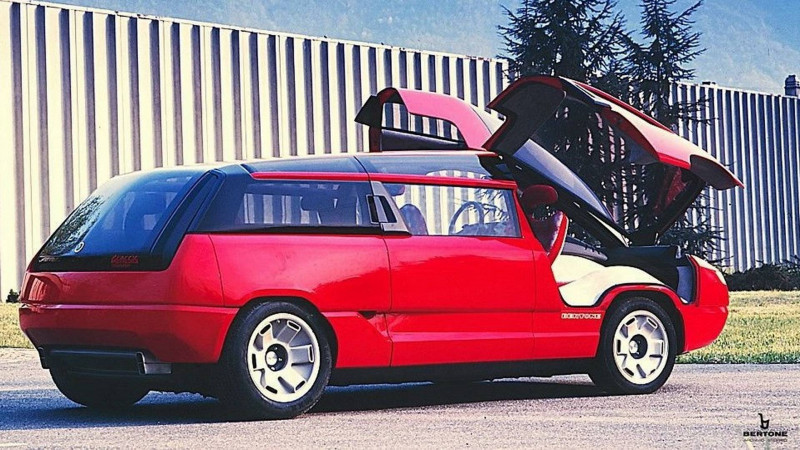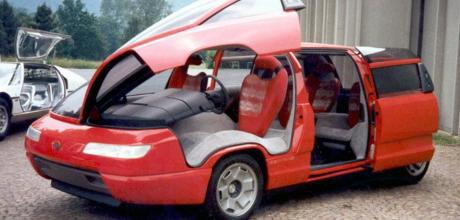1988 Bertone Genesis
It was just what the world had been crying out for: an MPV with a chain-driven, quad-cam V12 up front. Not that Bertone was down with the whole labels thing, you understand. The Genesis was merely a teaser; one that defied easy categorisation. It’s just that everyone who clapped eyes on this crimson machine at the 1988 Turin motor show dubbed it a people carrier, even if it could accommodate only five occupants. Everyone, that is, apart from America’s Autoweek which ran the coverline: ‘Is this the shape of the next great Italian supercar?’
ON THE FRINGE Bertone Genesis
The precise backstory behind the Genesis’ creation is mired in conjecture. What is beyond question is that it was conceived internally despite it often being referred to (erroneously) as the Lamborghini Genesis. Stile Bertone had enjoyed a long and symbiotic relationship with the firm stretching back to the mid- 1960s, the Miura, Countach, Espada, Urraco and more having been shaped by the Turinese design house. Nevertheless, the relationship had cooled appreciably during the 1980s, primarily because Lamborghini tended to be perennially strapped for cash, or worse. Then into the breach stepped the Chrysler Corporation. In 1987, the smallest of Detroit’s Big Three purchased Automobili Lamborghini. This was during a period where it was on an image-building quest having only narrowly staved off ruination less than a decade earlier. The first fruit of this Italo-American relationship was the over-ripe Portofino concept saloon which appeared at the Frankfurt motor show later that same year. This Jalpa V8-engined machine was styled Stateside by Kevin Verduyn who later gave the world the Plymouth Prowler.

It could be surmised that Bertone feared that its association with the Sant’Agata marque, even one that had ebbed since the late 1970s, was at risk, hence the decision to build something with Lamborghini power. The Genesis was shaped by resident styling chief Marc Deschamps, an under-appreciated talent who résumé includes everything from the wild Lamborghini Athon show-stopper to the Citroën XM. He had a large canvas on which to work, too, the finished article emerging some 4750mm long, 2057mm wide, and 1524mm tall.
Nuccio Bertone was quoted in the press release as saying: “Genesis represents a vision of a possible GT car for coming decades which incorporates the mobility and comfort requirements of the near future.”
Deschamps attempted to provide a visual ‘break’ by means of a body-colour delineation within the expansive glasshouse. It worked, even if it lent the impression that there were two distinct canopies. Inside, the occupants up front sat separated by the 48-valve V12 powerhouse which was manacled to a three-speed Chrysler TorqueFlite automatic transmission. That said, they effectively sat atop the vast inner wheel arches, and there was barely anything by way of front overhang. Crumple zones? What crumple zones? As for it being a five-seater, that was a bit of a misnomer because it could accommodate four in comfort, but the fifth poor soul had to make do with a small fold-down jump seat.
Despite being at pains to play down categorisations, particularly when dealing with the media, studio principal Nuccio Bertone was quoted in the press release as saying: ‘Genesis represents a vision of a possible GT car for coming decades which incorporates the mobility and comfort requirements of the near future.’ Intriguingly, Giorgetto Giugiaro clearly felt the same given that his Italdesign concern displayed the conceptually similar PR770 at the same event. It was a ‘one box’ offering which employed Audi 200 quattro running gear (the engine being sited amidships), but visually it looked as though it had wandered off the set of a Hollywood Sci-Fi opus.
Both designs were mauled by the media, at least for the most part. The Genesis didn’t act as a calling card, either, because Bertone never shaped another Lamborghini production car again. It did, however, foretell the current obsession with mega-horsepower people movers, witness the Lamborghini Urus. Truth be told, though, the Genesis was a nonfunctional ‘pish-mobile’.


